Hawaii Volcanoes National Park Hikes will put you in the heart of this park's (Or Pele's) fiery past, present, and future!
The park is rich in Hawaiian culture, unique lava formations, tropical rainforests, and wildlife like no other seen on the planet.
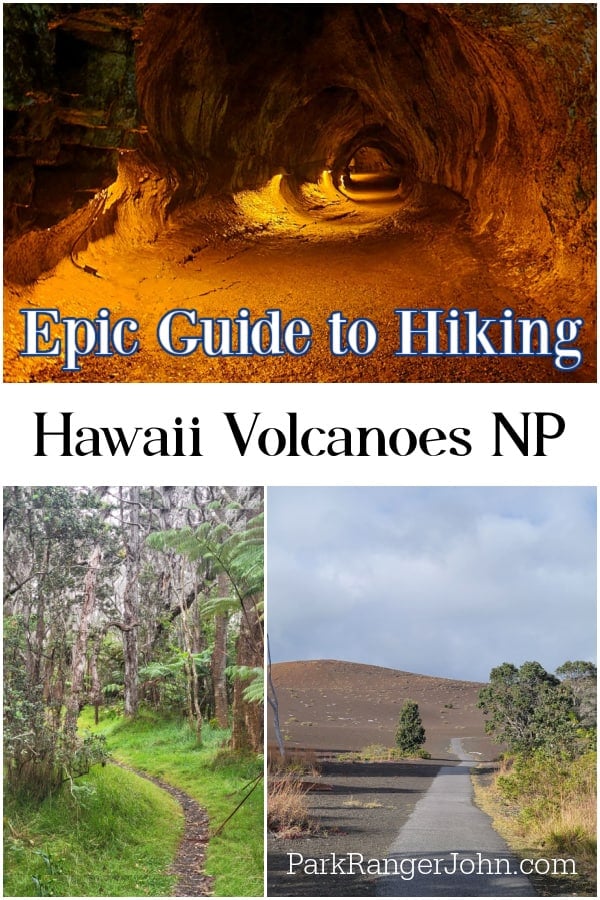
Hawaii Volcanoes National Park Hikes
When most people think of taking a vacation to the Big Island of Hawaii, they think of visiting the sunny Kona Coast for epic sunsets, golfing, swimming at one of the incredible beaches, and relaxing with a mai tai or two.
Did you know that a short 100 miles (a little over two hours drive time) will put you in the tropical rainforest of Hawaii Volcanoes National Park?
Here you can take one of several amazing day hikes with over 100 miles of trails located within the 523 square miles of Hawaii Volcanoes.
You can find something for everyone from an easy walk through a tropical rainforest to longer hikes that include a strenuous steep climb up the summit of the world's tallest volcano with breathtaking views.
Common Questions about Hawaii Volcanoes National Park Hikes
What are the most popular and best hiking trails in Hawaii Volcanoes National Park?
Kīlauea Iki, Devastation Trail, and Nāhuku Thurston Lava Tube Trail are probably the most popular trails in the park
What are the best easy hikes in Hawaii Volcanoes National Park?
Three of the best easy hikes include the Kīpukapuaulu (Bird Park) Trail, Devastation Trail, and Nāhuku Thurston Lava Tube Trail
Are pets allowed on trails in Hawaii Volcanoes National Park?
Pets are prohibited on all front-country and backcountry trails in the Park.
What is my favorite hike in Hawaii Volcanoes National Park?
I'm a bird nerd so needless to say I love exploring for native Hawaiian birds along the Kīpukapuaulu (Bird Park) Trail
Can you hike to see active lava in Hawaii Volcanoes National Park?
One thing to remember is the volcanic conditions/lava flow can change at any time!
View the eruption update courtesy of the USGS Hawaiian Volcano Observatory for the most up-to-date information.
Our friends over at 2TravelDads wrote this epic Hawaii Lava Glow article filled with tips on seeing the lava.
Make sure to keep an eye out for rope lines and hazard signs! The park designates areas that may have potentially lethal volcanic fumes, unpredictable rim collapses, hidden earth cracks, and other hazards.
Check the air quality before and during your visit.
Do you need a permit to hike in Hawaii Volcanoes NP?
Currently, you do not need a permit to go hiking in the park. You will need a permit if you plan to enjoy backcountry camping off of one of the longer trails.
For backcountry camping, there is a non-refundable $10.00 fee per trip, in addition to the park entrance fee. The fee is good for up to 10 people and 7 nights per permit.
All eight backcountry campsites (Ka‘aha, Halapē, Keauhou, ‘Āpua Point, Nāpau, Pepeiao Cabin, Red Hill Cabin, and Mauna Loa Cabin) require a permit, with a stay limit of three consecutive nights at one site.
What should I wear when hiking in Hawaii Volcanoes NP?
We always suggest having the ten essentials with you when hiking. Hawaii Volcanoes NP Hikes can have different trail conditions from other parks.
You need to be prepared for walking on uneven lava rock depending on the trails you plan to explore.
Make sure to bring a first aid kit, trail map, signaling device, plenty of water, sunscreen, hat, sunglasses, and anything you need for the day.
Hikers are required to pack out everything they pack in.
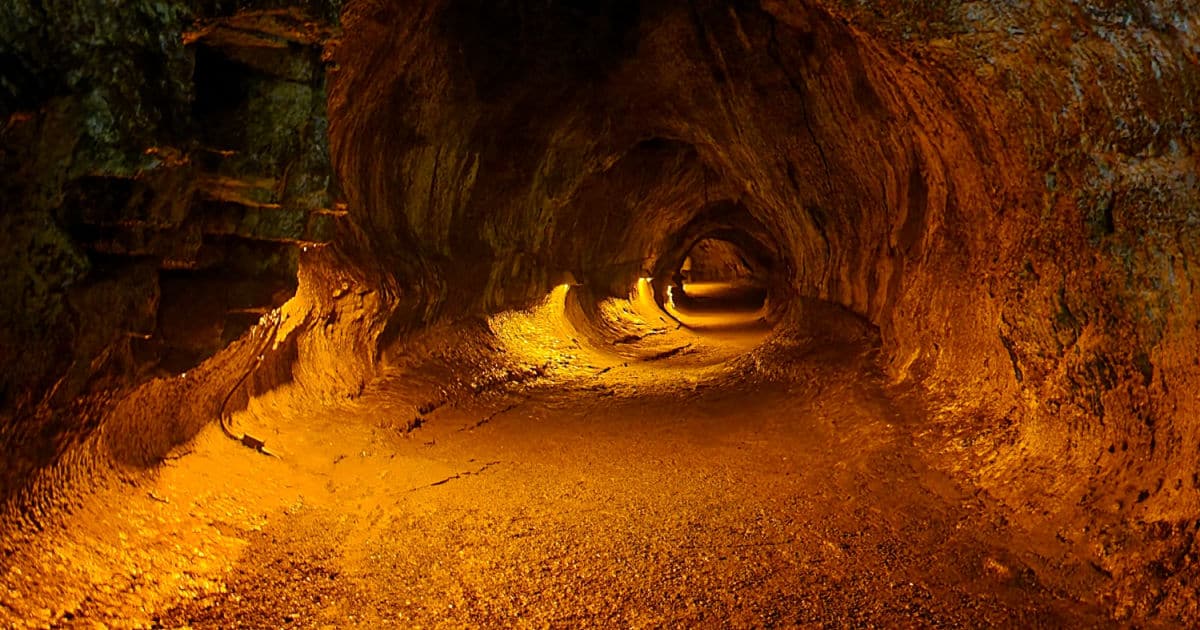
Easy Hikes in Hawaii Volcanoes National Park
Nāhuku Thurston Lava Tube Trail
- Trail Length: 0.5 Miles
- Elevation gain: Approx. 50 feet
- Difficulty rating: Easy Trail
- Time: 30 minutes
- Location: Nāhuku (Thurston Lava Tube) parking area and Kīlauea Iki Overlook (Overflow Parking Area)
Quite simply, this is one of my favorite short hikes in the National Park System! The cool lush dense rain forests are very welcoming after spending a few days in the intense sun from the Kona side of the island! I am pretty sure I have had everything from mist to rainfall each time I have taken this hike and loved it. You also hear all the birds chirping surrounded by lush flora and fauna and then the big payoff, the lava tube. What an experience!
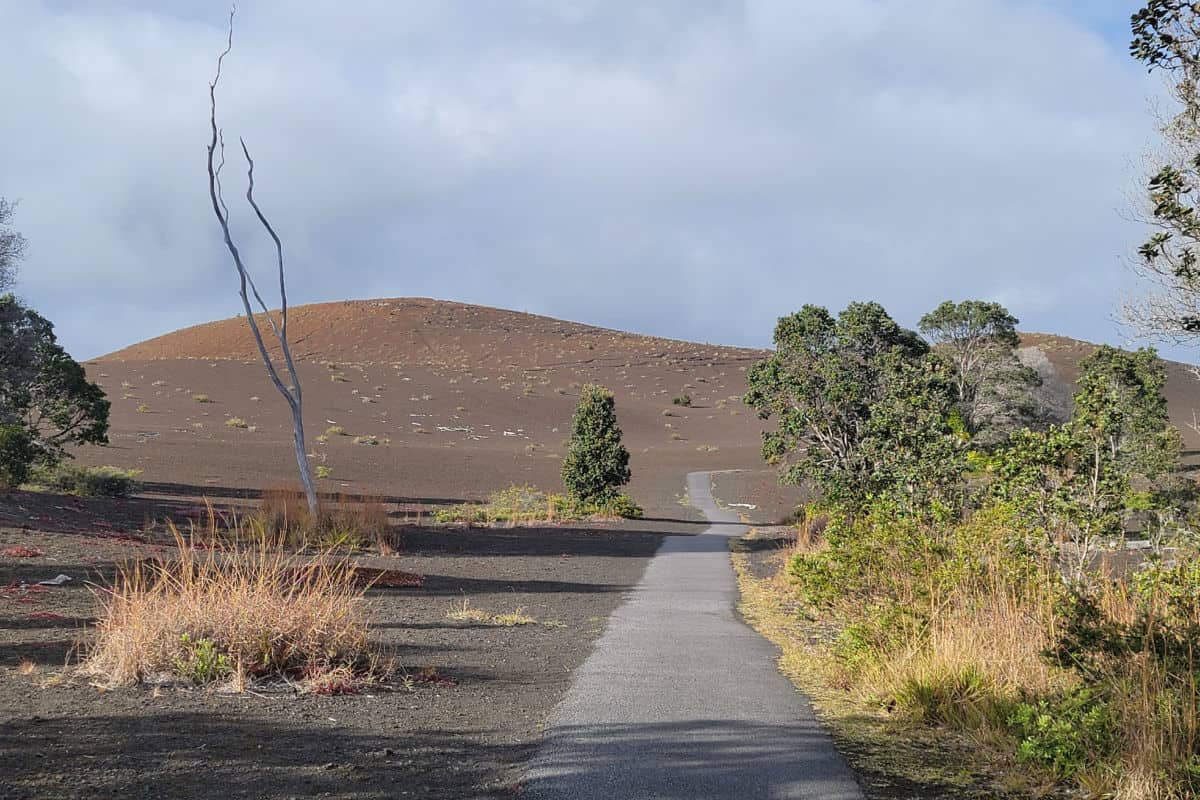
Devastation Trail
- Trail Length: 1.0 Mile Roundtrip
- Elevation gain: 125 feet
- Difficulty rating: Easy Trail
- Time: Approximately 1 hour
- Location: Devastation Trail parking lot on Crater Rim Drive.
This is another fantastic short hike! You start at the trailhead in trees and after a short walk, you begin to understand the name of the trail. You quickly see the trees and vegetation along the trail get replaced with rock/cinder from the 1959 Kilauea Iki eruption.
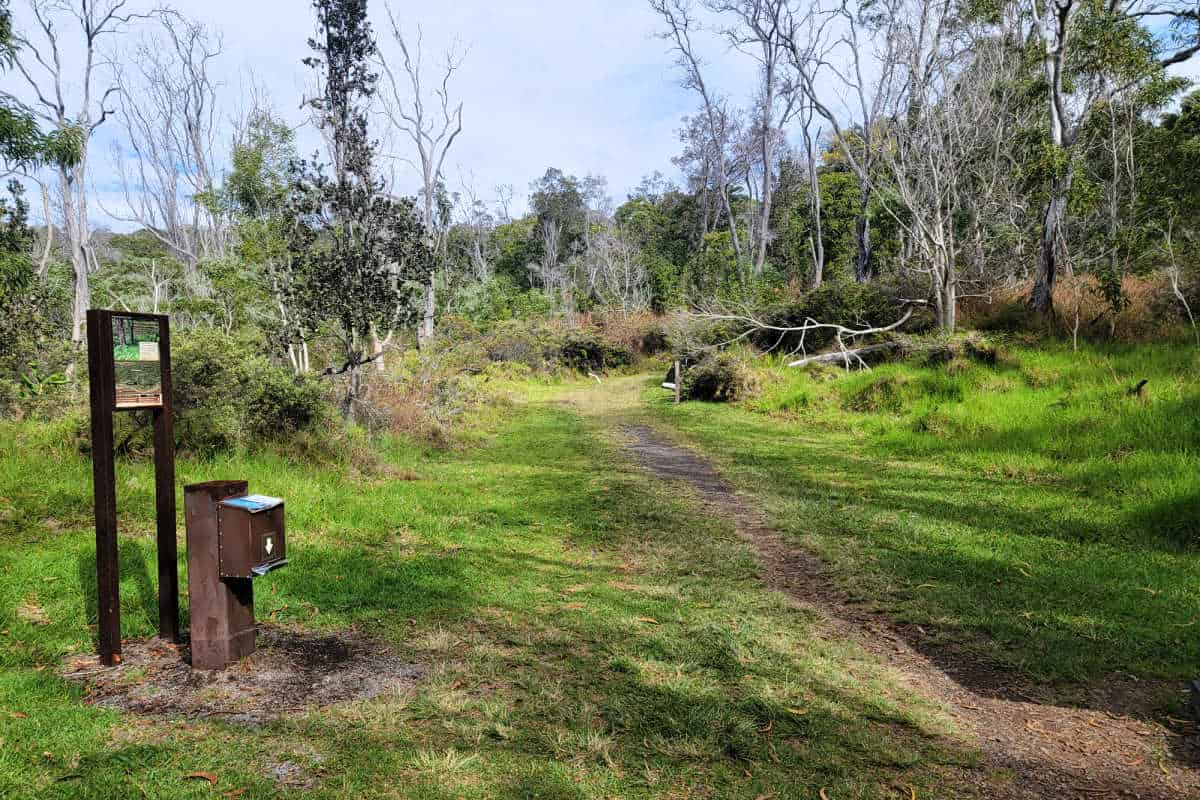
Kīpukapuaulu (Bird Park) Trail
- Trail Length: 1.2 Mile Roundtrip loop trail
- Elevation gain: approximately 175 feet
- Difficulty rating: Easy Trail
- Time: Approximately 1 hour (Unless you are a bird nerd like me then perhaps hours!
- Location: Kīpukapuaulu parking area.
The Kīpukapuaulu Trail was constructed in 1934 by the Civilian Conservation Corps, commonly known as the (CCC). This trail is full of plant and animal diversity and is commonly called Bird Park.
The Kipukapuaulu has more native tree species per acre than any other forest in Hawaii Volcanoes National Park. It is common to see Kalij pheasants in this area although they are not native to the islands and do create a problem with weed growth and native vegetation.
Bird enthusiasts, like myself, are looking for some of the local birds that make this home including the ʻelepaio, 'Apapane, 'Amakihi, and the 'I'iwi.
The best way to enjoy this trail is to hike this trail is choosing the best time to visit. Early mornings or later in the afternoon is the ideal time to visit because that is when birds are most active.
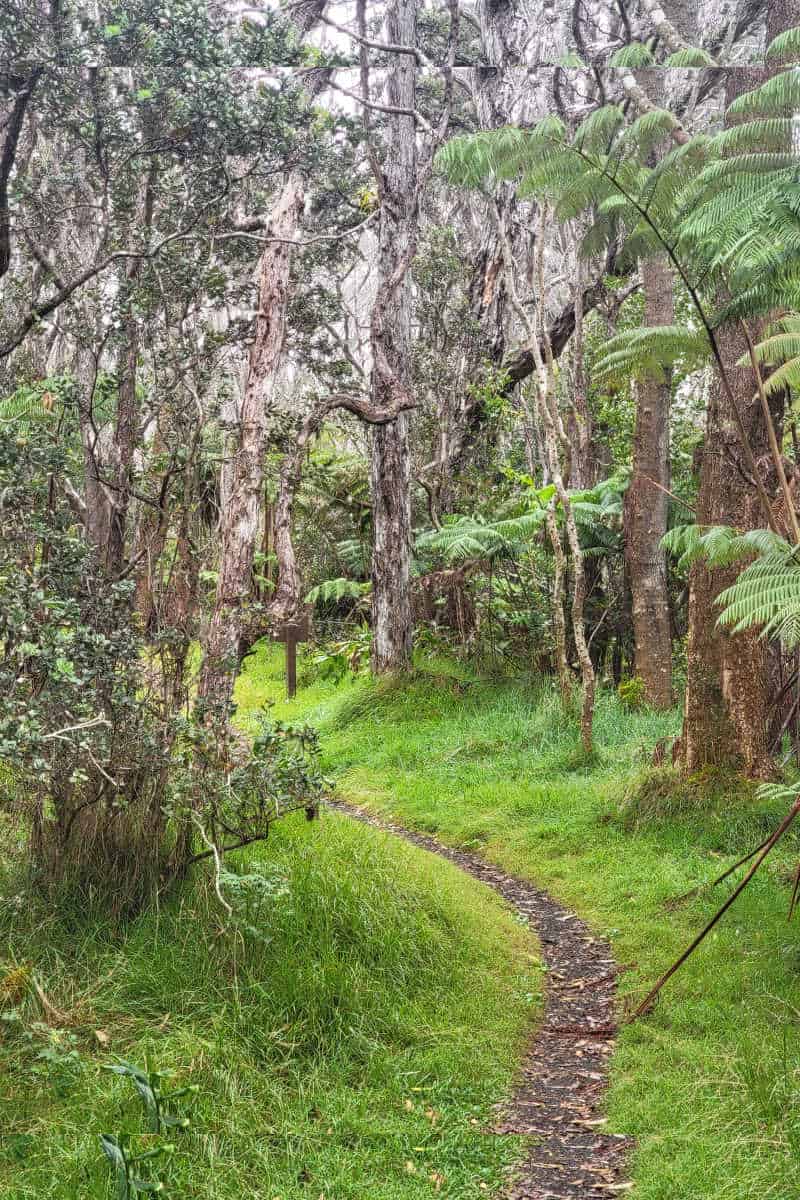
Crater Rim Trail
- Trail Length: Up to 11 miles. The trail stretches from Uekahuna to just past Keanakako'i Crater around Kilauea's Summit. This includes the Kupina'i Pali (Waldron Ledge) trail. (Most go on a portion of the trail of their choosing)
- Elevation Gain: minimal
- Difficulty Rating: easy
- Time: a few minutes to several hours
- Location: Multiple trail access locations throughout the park along the Kilauea Caldera
This is a great trail that has a little bit of everything all the while following along the edge of one of the most active volcanoes on planet earth! Here you will get to see rainforests, steam vents, and much more!
Ha'akulanu (Sulphur Banks) Trail
- Trail Length: 1.2-mile round trip
- Elevation Gain: approximately 100 feet
- Difficulty Rating: easy
- Time: 30 minutes to an hour
- Location: Kīlauea Visitor Center parking lot toward the Volcano Art Center Gallery
This easy trail will take you by several steam vents that have volcanic gases seep out of the ground along with groundwater steam. These gases are rich in carbon dioxide, sulfur dioxide, and hydrogen sulfide. It's really cool how close you get to the steam vents and children like them too!
- It is advised that any park visitor who has heart or respiratory conditions (such as asthma), pregnant women, infants, or young children should avoid this walk.
Kupina'i Pali (Waldron Ledge) Trail
- Trail Length:1.0 mile roundtrip to overlook
- Elevation Gain:
- Difficulty Rating: Easy
- Time: Approximately 45 minutes to 1 hour
- Location: Across the street from Kilauea Visitor Center, to the left of the Volcano House, and down the service road to the rock wall on the left.
Also known as the earthquake trail as it was originally part of the Crater Rim Drive. On 11/16/83, a 6.7 magnitude earthquake struck the island and destroyed portions of the Crater Rim Road. The road was rerouted to its current location we see today but now visitors take this trail and can see firsthand the effects of earthquakes.
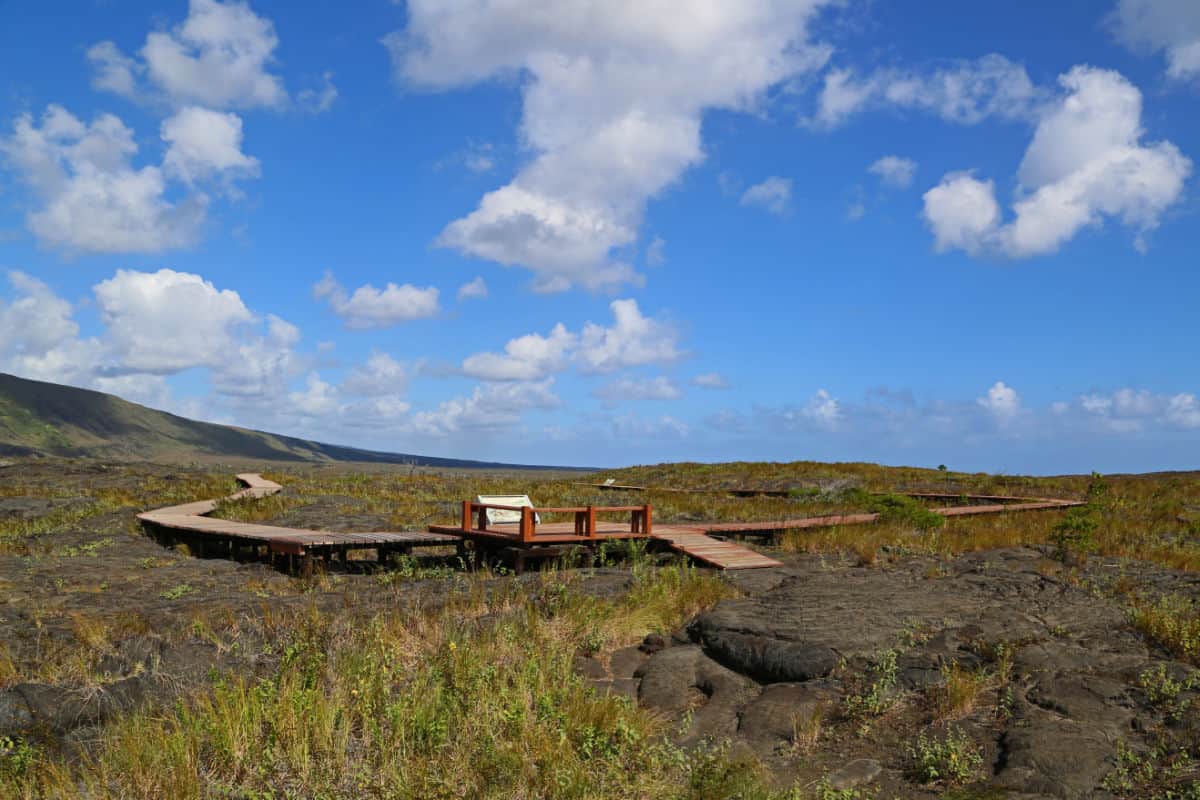
Moderate Hikes in Hawaii Volcanoes National Park
Puʻuloa Petroglyphs
- Trail Length: 1.4 Miles round trip out and back trail
- Elevation gain: approximately 100 Feet
- Difficulty rating: Moderate Hike
- Time: One to One and a half hours
- Location: Puʻuloa parking area on Chain of Craters Road.
Although there is little elevation gain, this is definitely a moderate trail. You quickly find that this 1.4-mile out-and-back trail crosses over a lava field and requires you to actually watch where you are going.
There is no shade on this trail and it warms up considerably when you reach this trailhead after leaving the comfortable tropical rainforest higher up on the mountain!
Is it worth your time then? YES! Soon enough you will reach the boardwalk pictured above and you will be surrounded by petroglyphs!
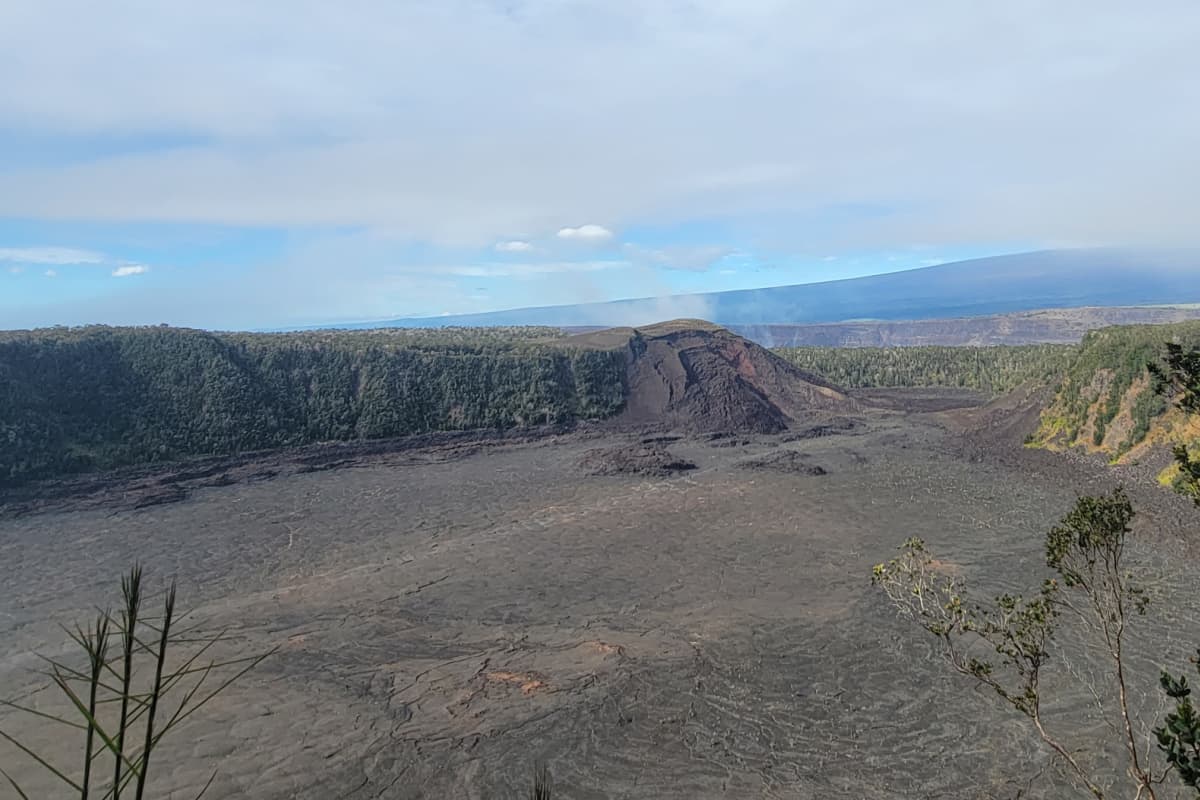
Kīlauea Iki Trail
- Trail Length: 3.3-mile loop trail
- Elevation Gain: approximately 400 feet
- Difficulty Rating: Moderate to Strenuous
- Time: 2 to 3 hours
- Location: Kīlauea Iki Overlook. Parking can be extremely limited
This is one of the busiest trails in the park so make sure to arrive early if you want to ensure that you get a parking spot at the trailhead, otherwise, you will have to park further away and hike to the trailhead.
One of the things that I found fascinating was the fact that you can see hikers on the trail below as it crosses the Kīlauea Iki crater.
This is also the place of the Kilauea Iki erupted in 1959 and lava began pouring into the lake bed below from a half-mile fissure.
Multiple vents consolidated into one main vent and over the next five weeks, lava continued to fill until eventually burying itself in a bed of lava. Today the lava lake has turned into rock and hikers walk across this fascinating feature.
Uēaloha (Byron Ledge)
- Trail Length: 2.2 miles roundtrip
- Elevation Gain: 200 Feet
- Difficulty: Moderate
- Time: One hour
- Location: Devastation Trailhead
The trail starts from the Devastation Trailhead, take a left and it will take you to Uealohe (Byron Ledge) trail.
This hike will take you to fantastic views of the Pu'upua'i Cinder Cone and glimpses into the Kaluapele (Kilauea Caldera)
Mauna Ulu Trail
- Trail Length: 2.5 Miles Roundtrip
- Elevation Gain: 210 feet
- Difficulty: Moderate
- Time: 2-3 hours
- Location: Mauna Ulu Trailhead on Chain of Craters Road
One of the fun features of this trail is that on a clear day, you can see both Mauna Loa and Mauna Kea! You also hike past lava trees and get great views of the Mauna Ulu lava shield.
The hike ends with a steep climb up Pu'u Huluhulu Cinder Cone.
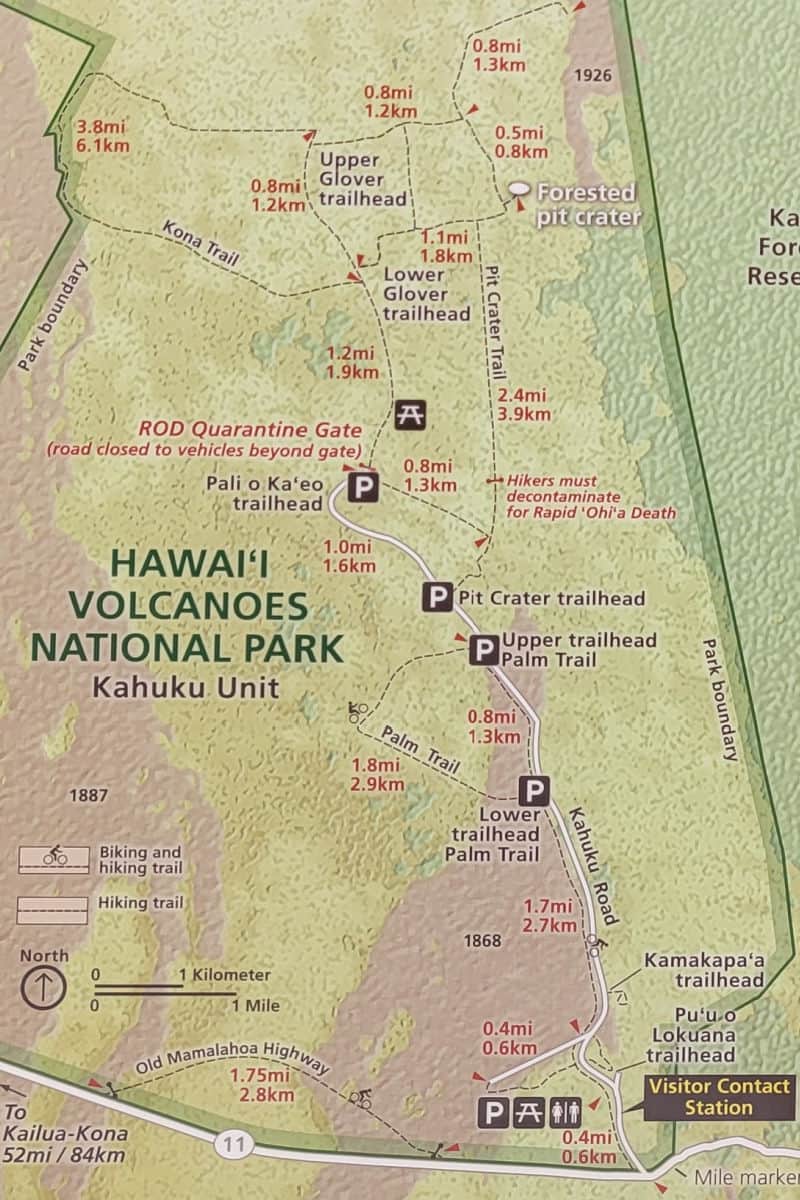
Pu'u o Lokuana Trail
- Trail Length: 2 miles loop trail
- Elevation Gain: 100 feet
- Difficulty: Moderate
- Time: One to one and a half hours
- Pu'u Lokuana Trailhead is located just past the visitor contact station at the Kahuku District of Hawaii Volcanoes National Park.
Pu'u Lokuana means grassy hill ahead but the name actually refers to an intense downpour of cinder from the fountains of lava that once stood here.
The trail will take you through pastures and lava fields before hiking to the top of a cinder cone with breathtaking views!
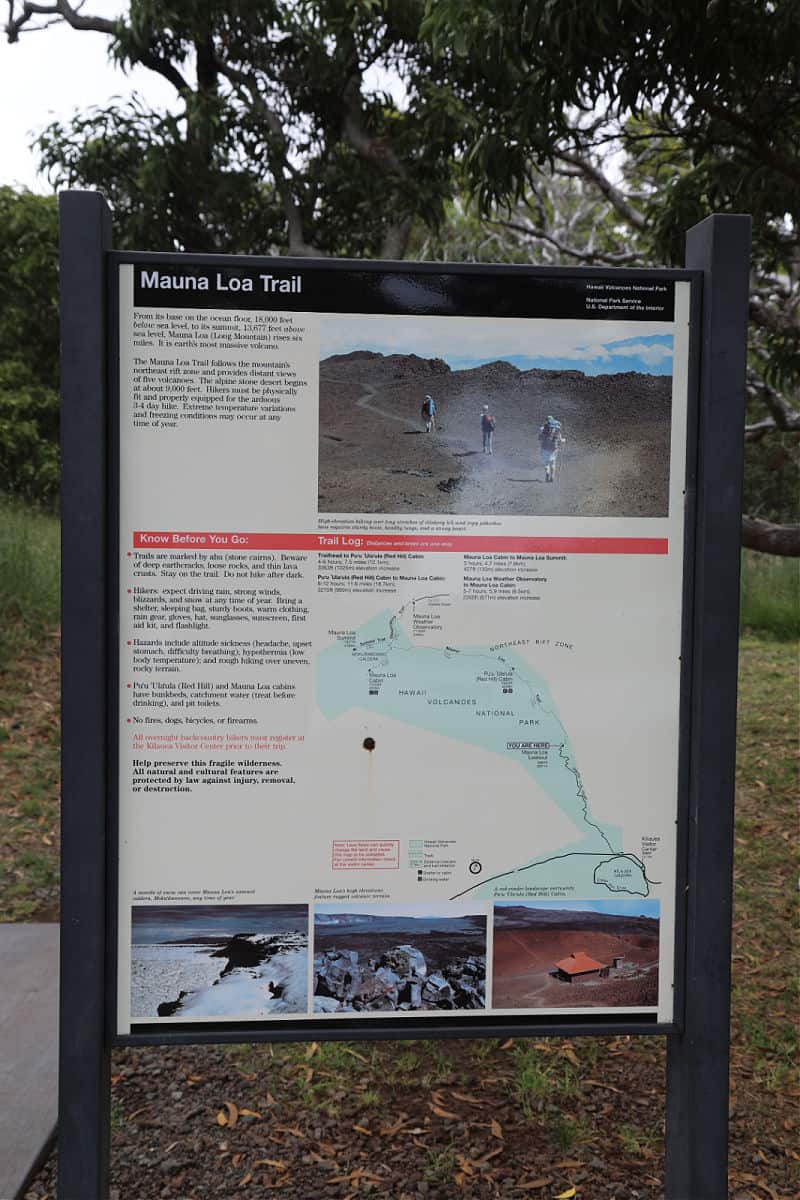
Strenuous/Difficult Hikes in Hawaii Volcanoes National Park
Mauna Loa Trail
*Currently Closed due to hazards from the recent eruption
Trail Length: 15 miles Out and Back to Puʻuʻulaʻula and an additional 23.2 mi from Puʻuʻulaʻula Cabin to Summit Cabin
Elevation gain: 3375 feet from the trailhead to Puʻuʻulaʻula and another 3650 feet to reach the summit of Moku'aweoweo Caldera.
Difficulty rating: Strenuous, actually I would consider this a challenging hike
Time: Depends on how long you want to stay and travel. A backcountry permit is required for overnight stays. Limited space is available for stays in cabins
Location: The Trailhead is at the Mauna Loa Lookout
Are you looking for an ultimate adventure? Does hiking to the summit of the world's largest volcano sound appealing? Mauna Loa is your peak!
If you were to measure this incredible volcano from the base of the volcano on the ocean floor to the summit of the volcano, Mauna Kea is over 33,000 feet tall! This easily makes Mauna Kea taller than any other volcano on Earth.
Now that you have decided you want to hike this trail, make sure to come prepared as it can be extremely rewarding but is not a simple day hike. Hikers here should be in excellent physical shape, know their limitations, have made reservations, obtained permits, researched, and come prepared.
The elevation gain is significant and ends at a whopping 13,678-foot summit of Mauna Loa. Make sure to read all the information on the NPS page about hiking to Mauna Loa before attempting.
I hope this list of the best hikes in Hawaii Volcanoes National Park helped you plan the perfect itinerary for your time in the park!
Luckily, there are hikes available for every experience level, so even if it’s your first time hiking, you’ll find plenty of opportunities to practice, just make sure you acclimatize properly in order to adjust to the altitude.
Have you ever visited Hawaii Volcanoes National Park? What are some other incredible hikes worth tackling? If you have any other recommendations, please feel free to drop them in the comment section below!
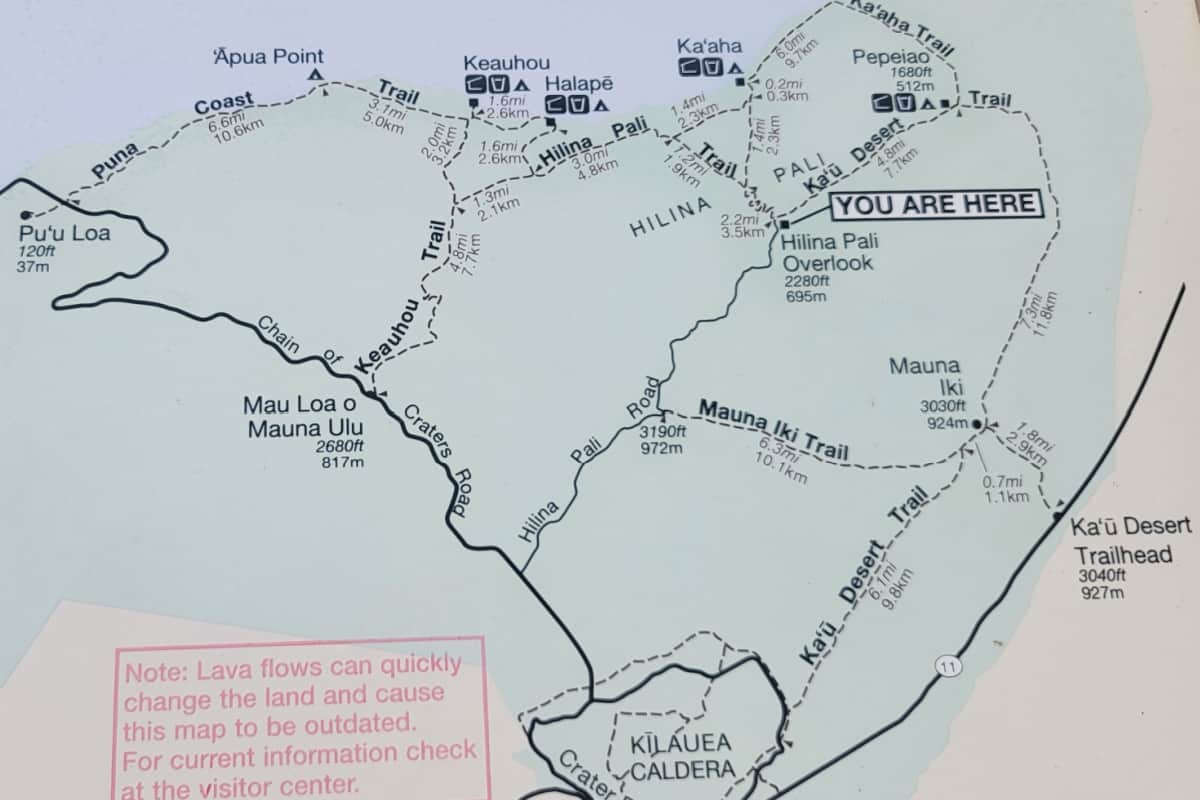
Additional Hawaii Volcanoes National Park information
Complete Guide to Hawaii Volcanoes National Park - This complete guide will help you plan a perfect trip to Hawaii Volcanoes National Park. Includes general park information, camping, lodging options, weather by season and so much more!
Things to do Hawaii Volcanoes National Park - include all the top activities to do while visiting Hawaii Volcanoes National Park!
Things to know before your visit to Hawaii Volcanoes National Park
Hawaii Volcanoes National Park Entrance Fee
Park entrance fees are separate from camping and lodging fees.
Park Entrance Pass - $30.00 Per private vehicle (valid for 1-7 days from the date of purchase)
Park Entrance Pass - Motorcycle - $25.00 Per motorcycle (valid for 1-7 days from the date of purchase)
Per-Person Entrance Pass - $15.00 Visitors 16 years or older who enter on foot, bicycle, or as part of an organized group not involved in a commercial tour.
Annual Park Entrance Pass - $55.00, Admits pass holder and all passengers in a non-commercial vehicle. Valid for one year from the month of purchase.
$40.00-$75.00 for Commercial Sedan with 1-6 seats and non-commercial groups (16+ persons)
$75.00 for Commercial Van with 7-15 seats
$100.00 for Commercial Mini-Bus with 16-25 seats
$200.00 for Commercial Motor Coach with 26+ seats
Learn more about National Park Passes for parks that have an entrance fee.
$80.00 - For the America the Beautiful/National Park Pass. The pass covers entrance fees to all US National Park Sites and over 2,000 Federal Recreation Fee Sites for an entire year and covers everyone in the car for per-vehicle sites and up to 4 adults for per-person sites.

Buy your pass at this link, and REI will donate 10% of pass proceeds to the National Forest Foundation, National Park Foundation, and the U.S. Endowment for Forestry & Communities.
National Park Free Entrance Days -Mark your calendars with the five free entrance days the National Park Service offers annually.
National Park Passport Stamps
You’ll be able to get your own National Park Passport stamps from the visitor center
We like to use these circle stickers for park stamps so we don't have to bring our passport book with us on every trip.
The National Park Passport Book program is a great way to document all of the parks you have visitied.
You can get Passport Stickers and Annual Stamp Sets to help enhance your Passport Book.
Accessibility
The National Park Service strives to make the parks accessible to all. Hawaii Volcanoes National Park has several landmarks that are easily accessible, like visitor centers, self-guided trails, campgrounds, scenic lookouts, and more.
There are three accessible trails within the park -
- Devastation Trail
- Kūpinaʻi Pali (Waldron Ledge)
- Kīpukapuaulu Trail
Guided Tours
Guided tours are a great way to explore the park!
Volcano NP Group or Private Hiking Tour - Step into the caldera of an active volcano on a group or private hike in Hawai'i Volcanoes NP. Trek through Hawaiian forests and Kilauea Iki Crater to reach the iconic Thurston Lava Tube.
From Kona - Mauna Kea Stellar Explorer
For an out-of-this-world experience, check out Maunakea Stellar Explorer. This thrilling adventure features nighttime astronomical observing as well as safe daytime solar viewing, with all ages welcome.
From Kona or Waikoloa - Volcano Discovery Tour
Journey to Hawaii Volcanoes National Park for an in-depth volcano experience. Your certified guide will share a mix of natural and cultural history about Hawaii's formation, illuminating the stories behind the ever-changing landscape of the Big Island.
Twilight Volcano and Stargazing Tour - Experience the Big Island’s most spectacular natural splendors on this small-group tour and discover the history, cultures, and geology of the island. Visit a Kona Coffee Farm and the magnificent Hawaii Volcanoes NP.
Volcano NP Tour with Lunch - Join a full-day nature tour offering an in-depth look at Hawaii. Discover diverse landscapes as you explore Hawaii Volcanoes National Park, Waipio Valley waterfalls, and Punalu’u Black Sand Beach.
Volcano NP E-Bike Ride with GPS Guide - Take a GPS E-bike Tour of the Hawaii Volcanoes NP and the Lava Viewing Area using your smartphone. Embark on an adventure packed with fun bike trails and roads.
Door Off Helicopter ride over Volcano and the Rainforest - There is no better vantage point than a helicopter and there is no bigger thrill than leaving the doors behind so there is nothing between you and the sights. On this scenic flight tour, soar over iconic waterfalls and glowing lava flow.
From Kona - Helicopter Tour with private landing in a secluded location.
Take a helicopter tour over Big Island for views of Hawaii’s famous volcanoes and mountains. Top it off with a private landing in a secluded location so you can enjoy your own piece of paradise.
Where to stay when visiting Hawaii Volcanoes National Park
There is one National Park Lodge within the park.
Volcano House is the Big Island of Hawaii's oldest hotel site and the only hotel/lodge within Hawaii Volcanoes National Park. The lodge was first built in 1846 and is perched on the rim of Kilauea and offers stunning views of the active volcano.
Lodging near the park includes:
Colony I at Sea Mountain - Guests of this beach condo building will appreciate convenient onsite amenities such as a spa tub or barbecue grills. Each condo provides a kitchen with a refrigerator, a stovetop, a microwave, and a dishwasher. Guests will appreciate conveniences like a washer/dryer and a coffee/tea maker, while a TV with cable channels and a DVD player provide a bit of entertainment.
The Inn at Kulaniapia Falls - 3.5-star boutique bed & breakfast by the river. Take advantage of a terrace, a garden, and a library at The Inn at Kulaniapia Falls. Active travelers can enjoy hiking/biking, rock climbing, and a ropes course at this bed & breakfast. Guests can connect to free Wi-Fi in public areas.
Outrigger Kona Resort - 4-star family-friendly resort by the ocean. In addition to shopping on site and a coffee shop/café, guests can connect to free in-room Wi-Fi.
Grand Naniloa Hotel Hilo - a Doubletree by Hilton - 4-star hotel in the heart of Keaukaha. Active travelers can enjoy cycling, snorkeling, and fishing at this hotel. Be sure to enjoy a meal at Hula Hulas, the onsite restaurant. Enjoy the 24-hour gym, as well as activities like boat tours, rowing/canoeing, and sailing. Stay connected with free in-room Wi-Fi, and guests can find other amenities such as dry cleaning/laundry services and a fireplace in the lobby.
National Park Camping
Season: Year-round
Campsites: 16
Accessibility: There are no Accessible sites
The campground is located off of the Hawaii Belt Road a few miles from the visitor center. There is a sign on the road reminding you where to turn.
Season: Year-Round
Campsites: 9
Accessibility: Three campgrounds are wheelchair accessible
Kulanaokuaiki Campground is located about 5 miles down the Hilina Pali Road
National Parks near Hawaii Volcanoes National Park
Haleakala National Park This complete guide will help you plan a perfect trip to Haleakala National Park. Includes general park information, camping, lodging options, weather by season and so much more!
National Park sites to visit near Hawaii Volcanoes National Park
PU‘UHONUA O HÖNAUNAU National Historical Park - Also known as the City of Refuge or Place of Refuge is a sacred site for Hawaiians. Visiting this park will give you tremendous insight and knowledge about the Hawaiian culture and way of life.
Kaloko Honokohau National Historical Park - preserves and shows the ingenuity of the native Hawaiians (kanaka maoli) used to survive in the hot and arid environment around Kona by the building of fishponds.
Pu`ukoholā Heiau National Historic Site- is an 86-acre park that protects one of the oldest structures in the National Park System. The Puukohola Heiau was built in 1790-91 by the Hawaiian leader Kamehameha I.
Check out all of the National Parks in Hawaii
Make sure to follow Park Ranger John on Facebook, Instagram, Pinterest, and TikTok





Leave a Reply